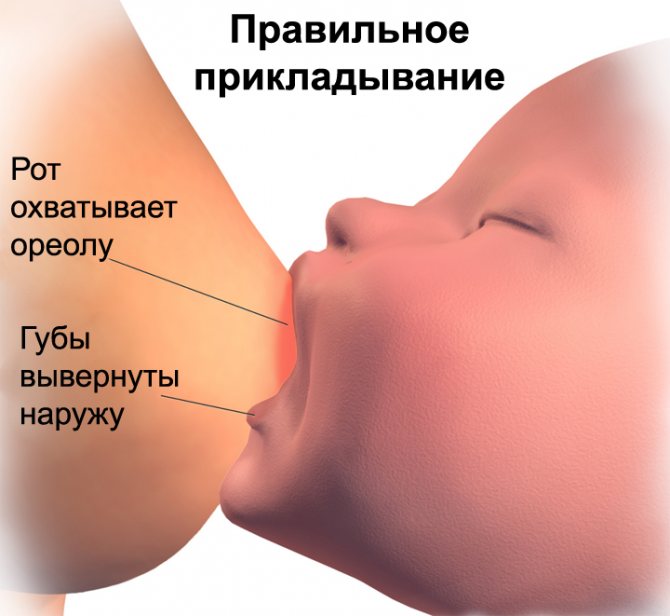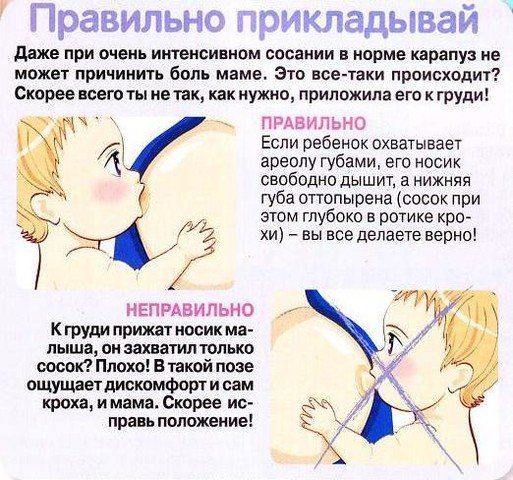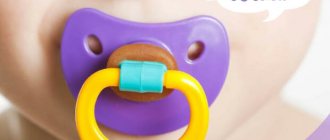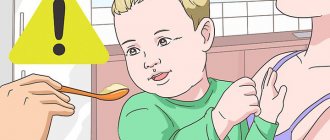First breastfeeding
Immediately after the baby is born, when he makes his first cry, the obstetrician cuts his umbilical cord and places the baby on the mother’s chest. Then the doctor places the mother's nipple directly to the baby's mouth, helps the baby grasp it and squeezes out a little colostrum from the mammary gland. Why do they do this? The fact is that babies are born with a sterile gastrointestinal tract, and it is very important that good microflora multiply there. The child has already received part of the microflora during passage through the birth canal, the second part he takes from colostrum. Thus, when the baby is first put to the breast, his stomach is filled with the mother’s microflora. In addition, colostrum contains special proteins - immunoglobulins, which perform a protective function. They protect the baby from the adverse effects of the environment, because the baby’s body is not yet able to withstand it on its own.
What happens next? Newborns cannot regulate their body temperature depending on the ambient temperature, so the baby is left on the mother’s chest for just a couple of minutes. Sometimes, to keep the baby from freezing, they cover him with a diaper. After this, the baby is washed and dressed on the changing table.
When will mommy feed him again? A woman can feed her baby no earlier than two hours after birth. She needs this time for her placenta to come out, for the new mother to be examined by a doctor, and for her to come to her senses after giving birth.
Correct attachment during breastfeeding: tips and videos
The best thing a woman can give her child is breast milk. Correct attachment during breastfeeding allows you to prolong the lactation period and avoid health problems.
Therefore, it is important for young mothers to teach their baby how to breastfeed correctly and to choose suitable feeding positions for themselves.
Table of contents
|
Why is correct application necessary?
Many women who have never breastfed believe that there is nothing difficult about it.
But in fact, this process requires considerable effort from both mother and baby.
If it was not possible to establish it from the very beginning, then problems such as:
- lactostasis or mastitis;
- cracked nipples;
- reducing the amount of milk or reducing its fat content;
- breast refusal.
All of the above situations can lead to the fact that the mother herself will have a desire to switch the baby to formula and not torment herself or him.
But you shouldn’t give up ahead of time. It is important to understand that proper feeding is based on two things:
- the child’s ability to suckle correctly;
- comfortable position of the mother.
Since a newborn can only rely on his instincts, the mother herself must teach him how to properly take the nipple into his mouth, and find a favorable position for himself.
Learning to apply correctly
In order for milk to come in, you need to monitor how the baby sucks at the breast.
It is a mistake to think that the baby should pay attention only to the nipple.
It is only a conductor of milk.
The areola, the surrounding area around it, needs stimulation. It is in it that the milky sinuses, responsible for lactation, are located.
Useful tips for mothers: BASIC FEEDING RULES
If the baby cannot latch on correctly, despite all his efforts, he will still remain hungry and dissatisfied, and the mother will only experience unpleasant and painful sensations.
To avoid this, you should teach him to suck correctly:
• observe the child while he is crying or yawning.
Remember how far he can open his mouth;
• before starting feeding, take the nipple with two fingers and move it along his lips from bottom to top, waiting until he opens them wide and captures the areola;
• make sure that the base of the chest rests against the palate, and that the lower jaw works well when sucking;
• hold the baby closer to you.
At the same time, you need to keep your back straight and not bend too much forward or backward.
If the baby does not pull on the nipple, eats calmly, and the mother does not experience pain, then we can assume that everything was done correctly.
Comfortable poses
Unlike proper breastfeeding, the choice of breastfeeding position is individual for each woman.
A few days after giving birth, the mother herself begins to understand how to feed her more comfortably.
You should never torture yourself and listen to the advice of experienced grandmothers who will tell you exactly how to sit or lie down.
Due to an awkward position that causes discomfort, the feeding process will not bring joy.
It is better to choose several convenient positions. Thanks to their alternation, milk will come from different points and will not stagnate in a certain place.
Poses you can use:
• lying stomach to stomach. The woman lies on her side, the newborn is pressed against her.
You can lean on your elbow or extend your arm parallel to the bed.
It is well suited for those who do not get enough sleep, since the baby can eat this way at night, dozing on his own, and without interfering with the mother’s doing this.
The main thing is to make sure that he does not roll over on his back.
To do this, you can place a cushion of a towel or blanket under his back;
• “cradle”. In this case, the child eats when the mother holds him in her arms.
You can feed while sitting, if there are no complications after childbirth, or standing while rocking him.
The child's head should lie on the bend of the elbow, and if the skill of proper sucking has not yet been developed, you should hold the head with your other hand, pressing it closer to you.
You can also use a special sling in which the baby will be fixed in the same position;
• hanging over the baby. To do this, you need to put him on a pillow, and sit on your knees or get on all fours, bend over his face, and give one of your breasts.
This position cannot be called the most comfortable, but it is necessary in order to periodically empty the central and lower channels of the mammary glands and prevent stagnation;
• baby on top. In this position, the mother lies on her back, and places the newborn on her stomach and cuddles her.
This position is not only comfortable. It helps fight infantile colic;
• from under the hand. You need to take a sitting position, put the baby on a pillow and place it under your arm.
This frees the side channels, where stagnation most often forms.
All the provisions proposed above can be modified. By changing them, a woman will not only avoid health problems, but will also only be able to rest and relax.
Feeding mistakes
In order to teach your baby to attach to the breast correctly, it is important to follow the following rules:
• It is important for the first months of life not to let the baby suck on anything other than the breast. To do this, it is better to postpone the purchase of bottles and pacifiers.
Rubber nipples, even with the most expensive and modern devices, cannot exactly replicate the shape of the mother's breast. They are much narrower.
Therefore, it will be difficult to teach a baby who is used to them to open his mouth wide.
Of course, with the help of silicone assistants, the lives of young parents are noticeably improved, but they are of little benefit to children;
• in case of severe damage to the breast, when it is not possible to feed in the usual way, there is no need to introduce the mixture into the diet.
It is best to express your milk and feed it to your baby;
• the main thing is that if the mother is okay with lactation, she has found positions that are comfortable for herself, but the baby still cannot grasp the areola correctly, you should definitely make sure that he is healthy and there are no deviations.
Some babies have a too narrow frenulum under their tongue, which prevents them from sucking properly.
This defect can be easily eliminated thanks to modern medicine, without causing much discomfort.
- about the author
- Recent publications
Svetlana Ovechkina
author of the publication (site editor)
TEACHER Higher pedagogical education. Director of the kindergarten.
Svetlana Ovechkina recently published (see all)
- Turkey as a first complementary food - 01/14/2021
- 7 month old baby’s daily routine – 03/28/2019
- Chocolate during breastfeeding - 03/25/2019
How to feed your baby in the first days?
The recommended break between feedings is about two hours. While the mother’s body produces very little milk - approximately 5 milliliters per day, the baby can eat this amount in 5-6 times. To be more precise, this is not milk yet, but colostrum, it is quite concentrated and this volume is quite enough for the baby; he will not be able to eat more for now. If you breastfeed your baby too often, your nipples may become cracked.
Does it happen that the baby is not latched to the breast? Fortunately, this does not happen often, it only happens in cases where the baby cannot breathe and suck on his own. Even if a young mother had a caesarean section, the baby is placed on the breast while she is still sleeping. The doctor himself places the baby on the mother’s breast and helps him latch onto the nipple.
We hope that the moment when you feed your baby for the first time will forever remain in your heart.
Proper application is the golden rule for further success

One of the most important moments that determine the course of the entire subsequent breastfeeding process can confidently be called the baby’s first latch. Failure here is fraught with a negative reaction from both the mother and the baby, who can easily refuse the breast. Most modern maternity hospitals can boast of medical assistance in the matter of first feeding. But, unfortunately, there are also opposite cases. Therefore, it is important for every woman to know the basic principles of how to properly attach a baby to the breast. How to apply to the breast correctly:
- Choose a comfortable position, taking into account that feeding can last quite a long time and you should not get tired. You can feed your baby in different positions and, as a rule, each woman chooses the one that she likes. But during the entire process, the baby must be with his tummy facing his mother, and his face must be turned towards the nipple. In addition, the baby’s head should not be rigidly fixed so that he can adjust the position of the nipple in the mouth and can inform the mother about the end of feeding (Material with photos and videos about various feeding positions);
- The newborn's nose should be close enough to the breast, but not sink into it, because if the baby reaches for the nipple, then there is a high probability of a superficial latch. Women with full breasts should be especially careful;
- Remember, the baby must take the nipple on his own. You don't need to put it in his mouth. Otherwise, the same incorrect grip will be ensured and the problems that will follow. If the baby only grabs the tip of the nipple, then by gently pressing the chin the mother can always free herself.

Video: feeding positions:
Breast grab: how to find the truth

But how do you know that your baby has taken the breast correctly? To do this, you just need to pay attention to the feeding process itself. It should look like this:
- The baby grabs both the areola and the nipple, and his lips turn outward;
- The baby's nose is pressed tightly to the mother's breast, but does not drown in it;
- During sucking, no extraneous sounds are heard except sips;
- Mom does not experience any discomfort during the process.
Photo gallery
(Pictures are clickable)
[sc:rsa]
How to properly attach a baby for feeding: problems and methods for solving them.
Scientific and popular articles and books are written about the importance of breastfeeding, discussions and heated discussions are devoted to it, but researchers agree on the main thing: mother’s milk is extremely important for the child. However, in addition to milk itself, as a valuable product, there is a whole range of related factors that are no less important than nutrition.
Contrary to popular belief, nature is not always able to tell you how to breastfeed a baby correctly, instincts will not help you position the nipple correctly in the baby’s mouth, and the consequences of incorrect latching can be extremely serious.










